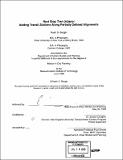Next stop Tren Urbano : adding transit stations along partially defined alignments
Author(s)
Berger, Noah S. (Noah Samuel), 1965-
DownloadFull printable version (21.03Mb)
Other Contributors
Massachusetts Institute of Technology. Dept. of Urban Studies and Planning.
Advisor
Joseph Coughlin.
Terms of use
Metadata
Show full item recordAbstract
The starting points of this thesis are the additions of two transit stations to the proposed route of San Juan Puerto Rico's new heavy rail system-Tren Urbano, which is currently under construction. The two stations-at the University of Puerto Rico and Domenech-were added late in the planning process, subsequent to submission of the Final Environmental Impact Statement (FEIS). As such, they offer interesting and provocative illustrations of the complexities, tradeoffs, and conflicts permeating station siting and spacing decisions. As stations are the interface points between the system and the communities through which it runs, where they are placed is critical to both system and community. In this vein, the approaches taken to adding stations to partially defined are alignments are considered, both at the theoretical and practical levels. At the theoretical level, three families of literature are identified, ranging from the narrowly-focused, system-level calculations of operational efficiency, to the neighborhood-level examinations of the bi-directional impacts of stations and communities on each other, to the broadly-focused, societal-level look at the role of social policy and politics on station location decisions. At the practical level, two sets of cases of actual station additions are examined: first, the recent San Juan cases, and second, examples from Boston, Massachusetts, where the added stations are now in operation and can thus be evaluated on the basis of their actual value to the community and system. Following analysis and evaluation of the San Juan and Boston cases, the thesis concludes with a set of guideposts to be used by planners and policy makers at Tren Urbano and, more broadly, other existing and proposed transit systems. By way of summary, the guideposts advise planners to pay attention to community input, but also to be aware that the most vocal members of a community are likely not to be representative of the greater community. In making station placement decisions, planners need to be cognizant of who will be served, who will not, and gather input from both. Certain types of areas are more likely to support a transit station than others-particularly dense, pedestrian oriented, historic centers. Institutionally, the cases provide clear evidence that both internal and external support is vital to the success of a station. Likewise, politics and history matters, and their impact should not be underestimated. Finally, planners should be explicit about the vision and goals underlying the transit system and be consistent about measuring proposals for station additions against those goals.
Description
Thesis (M.C.P.)--Massachusetts Institute of Technology, Dept. of Urban Studies and Planning, 1999. Includes bibliographical references (leaves [152]-156).
Date issued
1999Department
Massachusetts Institute of Technology. Department of Urban Studies and PlanningPublisher
Massachusetts Institute of Technology
Keywords
Urban Studies and Planning.